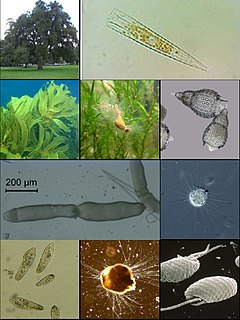Corticata
| Domaine | Eukaryota |
|---|---|
| Sous-domaine | Bikonta |
Règnes de rang inférieur
- Archaeplastida ou Plantae
- Chromalveolata s.l.
Les Corticata sont un clade d'eucaryotes bicontes décrit par Thomas Cavalier-Smith[1] qui rassemble les règnes Plantae[2] et Chromalveolata. Leur nom signifie « qui comporte un cortex ».
Définition modifier
Corticata signifie « dotés d'un cortex (écorce) ». Dans la classification des Eukaryota (organismes vivants avec un noyau cellulaire), Corticata est un clade présumé regroupant des deux clades eucaryotes suivants[3] :
- Plantae ou Archaeplastida (plantes terrestres, algues vertes, algues rouges et glaucophytes) ;
- Chromalveolata.
Cavalier-Smith y inclut dorénavant les Rhizaria, ce qui en fait un synonyme de Diaphoretickes (en)[4],[5],[6].
Sous-clades modifier
Phylogénie modifier
Cladogramme selon les études de Cavalier-Smith et Brown Heiss[7],[8]:
| Eukaryota |
| ||||||||||||||||||||||||||||||||||||||||||
Notes et références modifier
- T. Cavalier-Smith, « The phagotrophic origin of eukaryotes and phylogenetic classification of Protozoa », International journal of systematic and evolutionary microbiology, vol. 52, no Pt 2, , p. 297–354 (PMID 11931142)
- T. Cavalier‐Smith, « Megaphylogeny, cell body plans, adaptive zones: causes and timing of eukaryote basal radiations », The Journal of eukaryotic microbiology, vol. 56, no 1, , p. 26–33 (PMID 19340985, DOI 10.1111/j.1550-7408.2008.00373.x)
- (Cavalier-Smith et al. 2015)
- Cavalier-Smith, Thomas, « Kingdoms Protozoa and Chromista and the eozoan root of the eukaryotic tree », Biology Letters, vol. 6, no 3, , p. 342–345 (PMID 20031978, PMCID 2880060, DOI 10.1098/rsbl.2009.0948)
- Thomas Cavalier-Smith, Ema E. Chao, Elizabeth A. Snell, Cédric Berney, Anna Maria Fiore-Donno et Rhodri Lewis, « Multigene eukaryote phylogeny reveals the likely protozoan ancestors of opisthokonts (animals, fungi, choanozoans) and Amoebozoa », Molecular Phylogenetics and Evolution, vol. 81, , p. 71–85 (PMID 25152275, DOI 10.1016/j.ympev.2014.08.012 )
- Thomas Cavalier-Smith, Ema E. Chao et Rhodri Lewis, « Multiple origins of Heliozoa from flagellate ancestors: New cryptist subphylum Corbihelia, superclass Corbistoma, and monophyly of Haptista, Cryptista, Hacrobia and Chromista », Molecular Phylogenetics and Evolution, vol. 93, , p. 331–362 (PMID 26234272, DOI 10.1016/j.ympev.2015.07.004 ) :
« The clade comprising Chromista and Plantae was originally called photokaryotes (Cavalier-Smith, 1999) but following a criticism that this misleadingly implied a common photosynthetic ancestry of both groups (which would be untrue if they are sisters as most evidence indicates, but true if chromists were nested within Plantae as a few trees have suggested) it was changed to corticates because both kingdoms have cortical alveoli in one or more phyla (Cavalier-Smith, 2003a; see also 2003b; Cavalier-Smith and Chao, 2003a). However Adl et al. (2012) introduced an entirely unnecessary, and less euphonious third synonym with no intuitive meaning – Diaphoretickes, which is destabilising and should not be used. To stabilise nomenclature we now formally establish superkingdom Corticata to embrace kingdoms Plantae and Chromista (i.e. to mean the same as the vernacular term ’corticates’ so either can be used as is appropriate). »
- Cavalier-Smith, T., Chao, E. E., Snell, E. A., Berney, C., Fiore-Donno, A. M., & Lewis, R. (2014). Multigene eukaryote phylogeny reveals the likely protozoan ancestors of opisthokonts (animals, fungi, choanozoans) and Amoebozoa. Molecular phylogenetics and evolution, 81, 71-85.
- Brown, M. W., Heiss, A. A., Kamikawa, R., Inagaki, Y., Yabuki, A., Tice, A. K., ... & Roger, A. J. (2018). Phylogenomics places orphan protistan lineages in a novel eukaryotic super-group. Genome biology and evolution, 10(2), 427-433.
